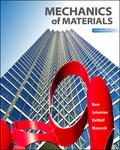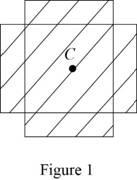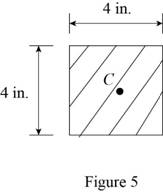
A short column is made by nailing four 1 × 4-in. planks to a 4 × 4-in. timber. Using an allowable stress of 600 psi, determine the largest compressive load P that can be applied at the center of the top section of the timber column as shown if (a) the column is as described, (b) plank 1 is removed, (c) planks 1 and 2 are removed, (d) planks 1, 2, and 3 are removed, (e) all planks are removed.

Fig. P4.112
(a)
Find the largest compressive load P that can be applied at the center of the top section of the timber column.
Answer to Problem 112P
The largest compressive load P is
Explanation of Solution
Given information:
The compressive load P is
The allowable stress
The width
The depth
The width
The depth
Calculation:
Sketch the centric loading as shown in Figure 1.

Refer to Figure 1.
Find the area of the timber section using the relation:
Substitute
Calculate the largest compressive load P using the relation:
Substitute
Thus, the largest compressive load P is
(b)
Find the largest compressive load P that can be applied at the center of the top section of the timber column without plank 1.
Answer to Problem 112P
The largest compressive load P that can be applied at the center of the top section of the timber column without plank 1 is
Explanation of Solution
Calculation:
Sketch the Eccentric loading as shown in Figure 2.

Find the area of the timber section using the relation:
Substitute
Refer to Figure 2.
Find the centroid
Substitute
Refer to Figure 2.
Find the moment of inertia
Substitute
Find the moment of inertia
Substitute
Find the total moment of inertia as follows:
Substitute
Calculate the largest compressive load P that can be applied at the center of the top section of the timber column without plank 1using the relation:
Here, e is the eccentricity, I is the moment of inertia, A is the area of cross section, and c is the distance between the centroid from extreme fibre.
Substitute
Thus, the largest compressive load P that can be applied at the center of the top section of the timber column without plank 1 is
(c)
Find the largest compressive load P that can be applied at the center of the top section of the timber column without plank 1and 2.
Answer to Problem 112P
The largest compressive load P that can be applied at the center of the top section of the timber column without plank 1 and 2 is
Explanation of Solution
Calculation:
Sketch the centric loading as shown in Figure 3.

Refer to Figure 3.
Find the area of the timber section using the relation:
Substitute
Calculate the largest compressive load P using the relation:
Substitute
Thus, the largest compressive load P is
(d)
Find the largest compressive load P that can be applied at the center of the top section of the timber column without plank , 2, and 3.
Answer to Problem 112P
The largest compressive load P that can be applied at the center of the top section of the timber column without plank 1, 2, and 3 is
Explanation of Solution
Calculation:
Sketch the Eccentric loading as shown in Figure 4.

Refer to Figure 4.
Find the area of the timber section using the relation:
Substitute
Find the centroid
Determine the moment of inertia (I) of eccentric section as follows:
Substitute
Calculate the largest compressive load P that can be applied at the center of the top section of the timber column without plank , 2, and 3 using the relation:
Here, e is the eccentricity, I is the moment of inertia, A is the area of cross section, and c is the distance between the centroid from extreme fibre.
Substitute
The largest compressive load P that can be applied at the center of the top section of the timber column without plank 1, 2, and 3 is
(e)
Find the largest compressive load P that can be applied at the center of the top section of the timber all columns are removed.
Answer to Problem 112P
The largest compressive load P that can be applied at the center of the top section of the timber all columns are removed is
Explanation of Solution
Calculation:
Sketch the centric loading as shown in Figure 5.

Refer to Figure 5.
Find the area of the timber section using the relation:
Substitute
Calculate the largest compressive load P using the relation:
Substitute
Thus, the largest compressive load P that can be applied at the center of the top section of the timber all columns are removed is
Want to see more full solutions like this?
Chapter 4 Solutions
EBK MECHANICS OF MATERIALS
- 1. The consequences of a head-on collision of two automobiles can be studied by considering the impact of the automobile on a barrier, as shown in figure below. Construct a mathematical model (i.e., draw the diagram) by considering the masses of the automobile body, engine, transmission, and suspension and the elasticity of the bumpers, radiator, sheet metal body, driveline, and engine mounts.arrow_forward3.) 15.40 – Collar B moves up at constant velocity vB = 1.5 m/s. Rod AB has length = 1.2 m. The incline is at angle = 25°. Compute an expression for the angular velocity of rod AB, ė and the velocity of end A of the rod (✓✓) as a function of v₂,1,0,0. Then compute numerical answers for ȧ & y_ with 0 = 50°.arrow_forward2.) 15.12 The assembly shown consists of the straight rod ABC which passes through and is welded to the grectangular plate DEFH. The assembly rotates about the axis AC with a constant angular velocity of 9 rad/s. Knowing that the motion when viewed from C is counterclockwise, determine the velocity and acceleration of corner F.arrow_forward
- 500 Q3: The attachment shown in Fig.3 is made of 1040 HR. The static force is 30 kN. Specify the weldment (give the pattern, electrode number, type of weld, length of weld, and leg size). Fig. 3 All dimension in mm 30 kN 100 (10 Marks)arrow_forward(read image) (answer given)arrow_forwardA cylinder and a disk are used as pulleys, as shown in the figure. Using the data given in the figure, if a body of mass m = 3 kg is released from rest after falling a height h 1.5 m, find: a) The velocity of the body. b) The angular velocity of the disk. c) The number of revolutions the cylinder has made. T₁ F Rd = 0.2 m md = 2 kg T T₂1 Rc = 0.4 m mc = 5 kg ☐ m = 3 kgarrow_forward
- (read image) (answer given)arrow_forward11-5. Compute all the dimensional changes for the steel bar when subjected to the loads shown. The proportional limit of the steel is 230 MPa. 265 kN 100 mm 600 kN 25 mm thickness X Z 600 kN 450 mm E=207×103 MPa; μ= 0.25 265 kNarrow_forwardT₁ F Rd = 0.2 m md = 2 kg T₂ Tz1 Rc = 0.4 m mc = 5 kg m = 3 kgarrow_forward
- 2. Find a basis of solutions by the Frobenius method. Try to identify the series as expansions of known functions. (x + 2)²y" + (x + 2)y' - y = 0 ; Hint: Let: z = x+2arrow_forward1. Find a power series solution in powers of x. y" - y' + x²y = 0arrow_forward3. Find a basis of solutions by the Frobenius method. Try to identify the series as expansions of known functions. 8x2y" +10xy' + (x 1)y = 0 -arrow_forward
 Elements Of ElectromagneticsMechanical EngineeringISBN:9780190698614Author:Sadiku, Matthew N. O.Publisher:Oxford University Press
Elements Of ElectromagneticsMechanical EngineeringISBN:9780190698614Author:Sadiku, Matthew N. O.Publisher:Oxford University Press Mechanics of Materials (10th Edition)Mechanical EngineeringISBN:9780134319650Author:Russell C. HibbelerPublisher:PEARSON
Mechanics of Materials (10th Edition)Mechanical EngineeringISBN:9780134319650Author:Russell C. HibbelerPublisher:PEARSON Thermodynamics: An Engineering ApproachMechanical EngineeringISBN:9781259822674Author:Yunus A. Cengel Dr., Michael A. BolesPublisher:McGraw-Hill Education
Thermodynamics: An Engineering ApproachMechanical EngineeringISBN:9781259822674Author:Yunus A. Cengel Dr., Michael A. BolesPublisher:McGraw-Hill Education Control Systems EngineeringMechanical EngineeringISBN:9781118170519Author:Norman S. NisePublisher:WILEY
Control Systems EngineeringMechanical EngineeringISBN:9781118170519Author:Norman S. NisePublisher:WILEY Mechanics of Materials (MindTap Course List)Mechanical EngineeringISBN:9781337093347Author:Barry J. Goodno, James M. GerePublisher:Cengage Learning
Mechanics of Materials (MindTap Course List)Mechanical EngineeringISBN:9781337093347Author:Barry J. Goodno, James M. GerePublisher:Cengage Learning Engineering Mechanics: StaticsMechanical EngineeringISBN:9781118807330Author:James L. Meriam, L. G. Kraige, J. N. BoltonPublisher:WILEY
Engineering Mechanics: StaticsMechanical EngineeringISBN:9781118807330Author:James L. Meriam, L. G. Kraige, J. N. BoltonPublisher:WILEY





